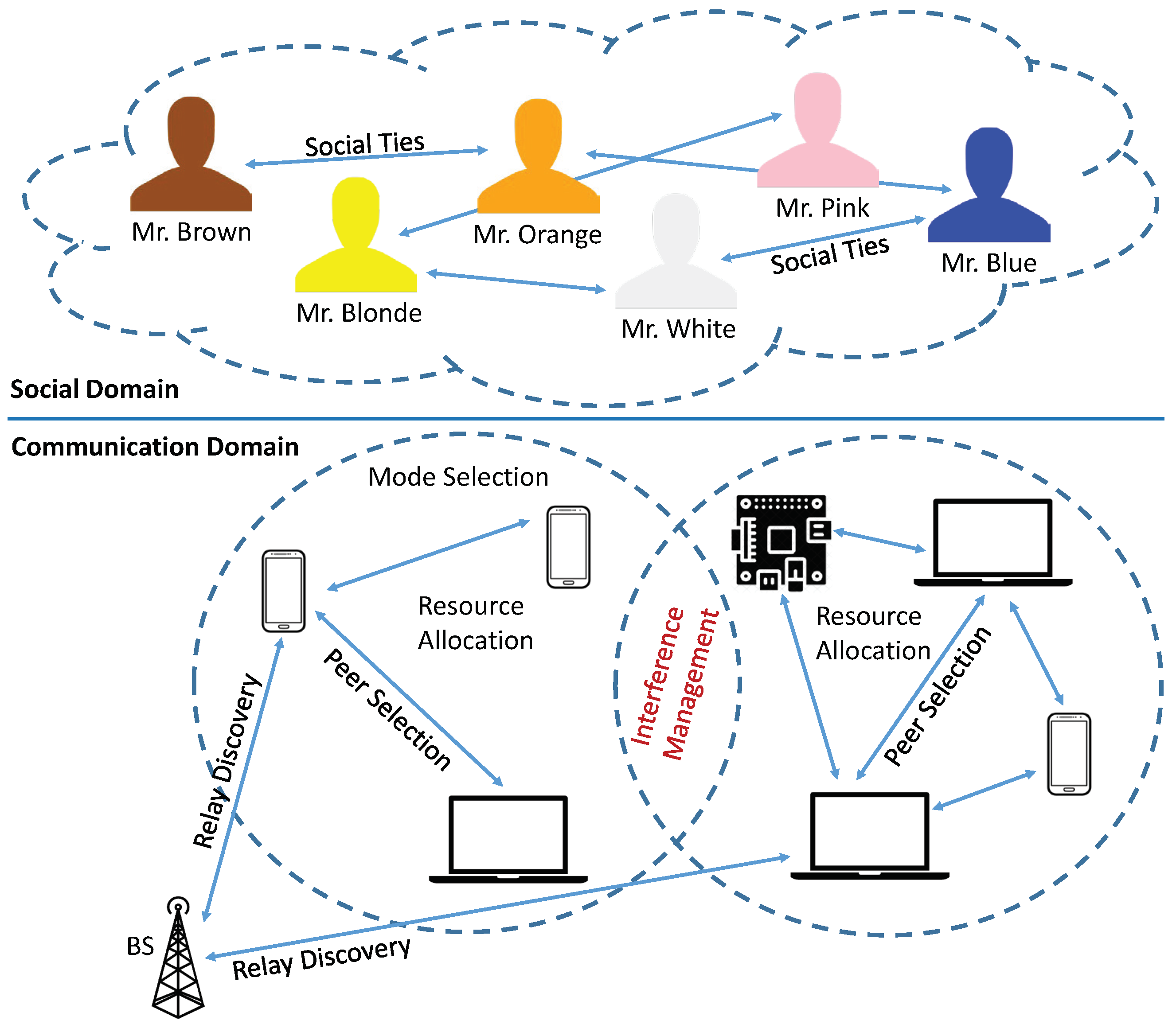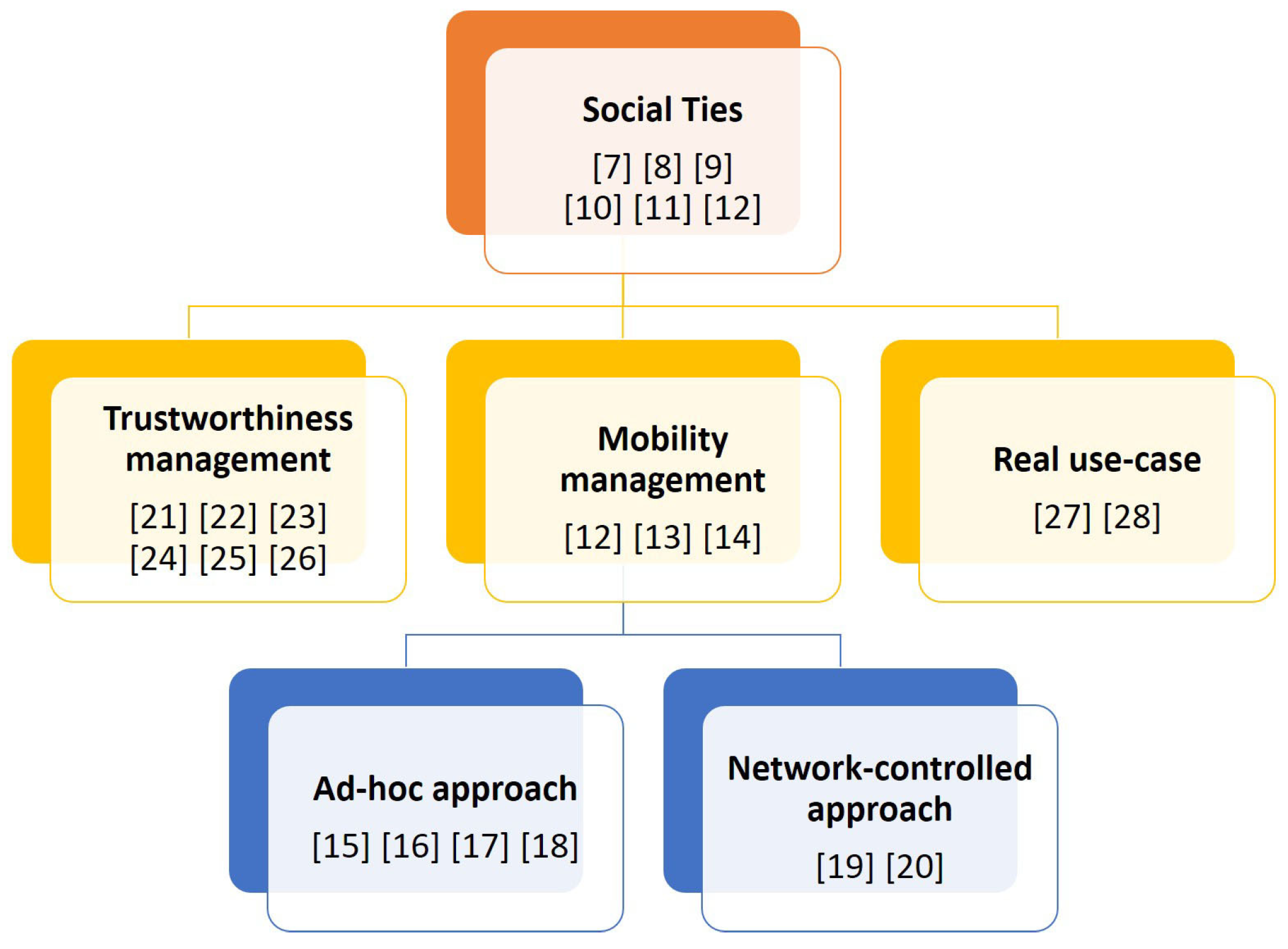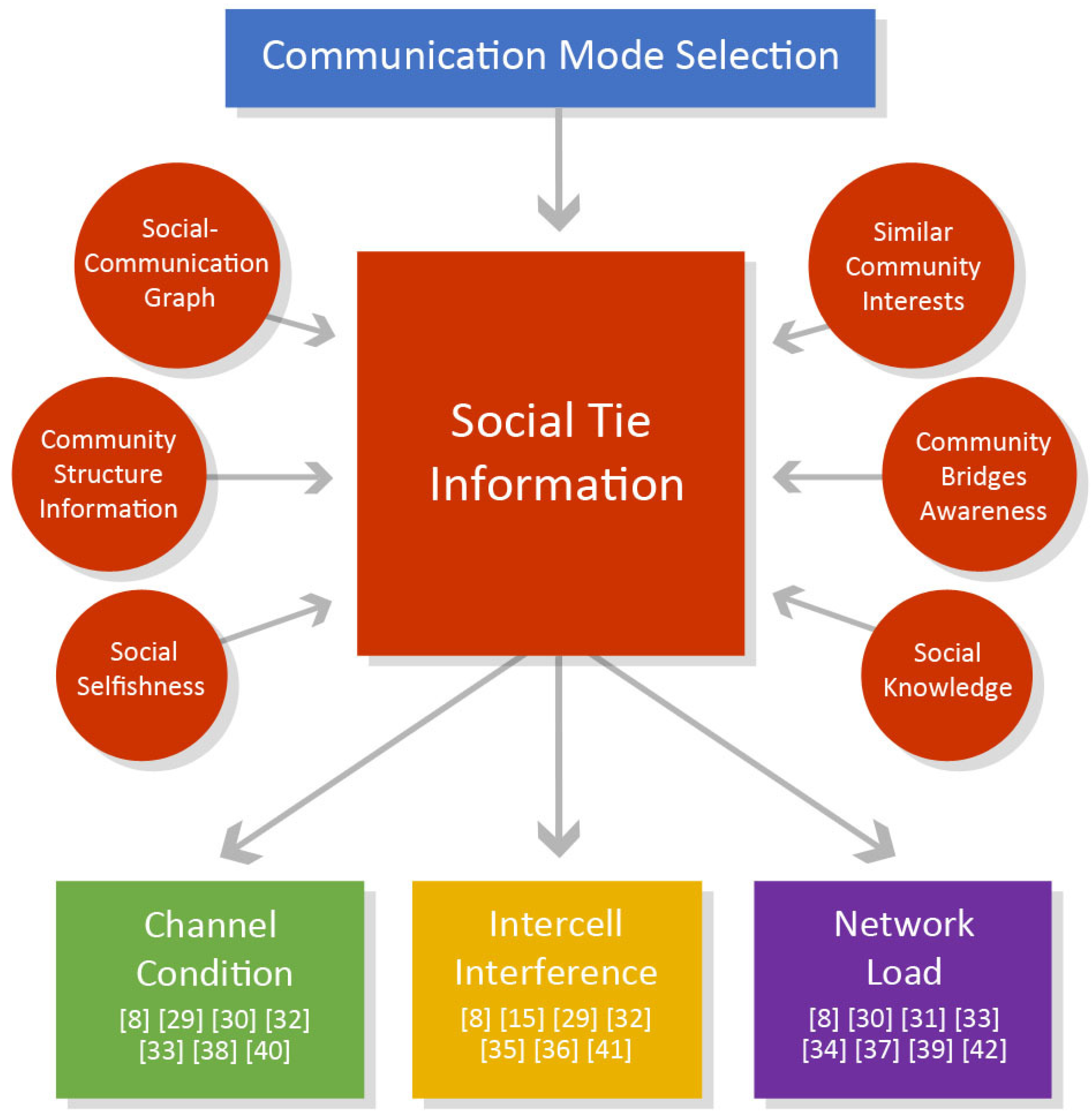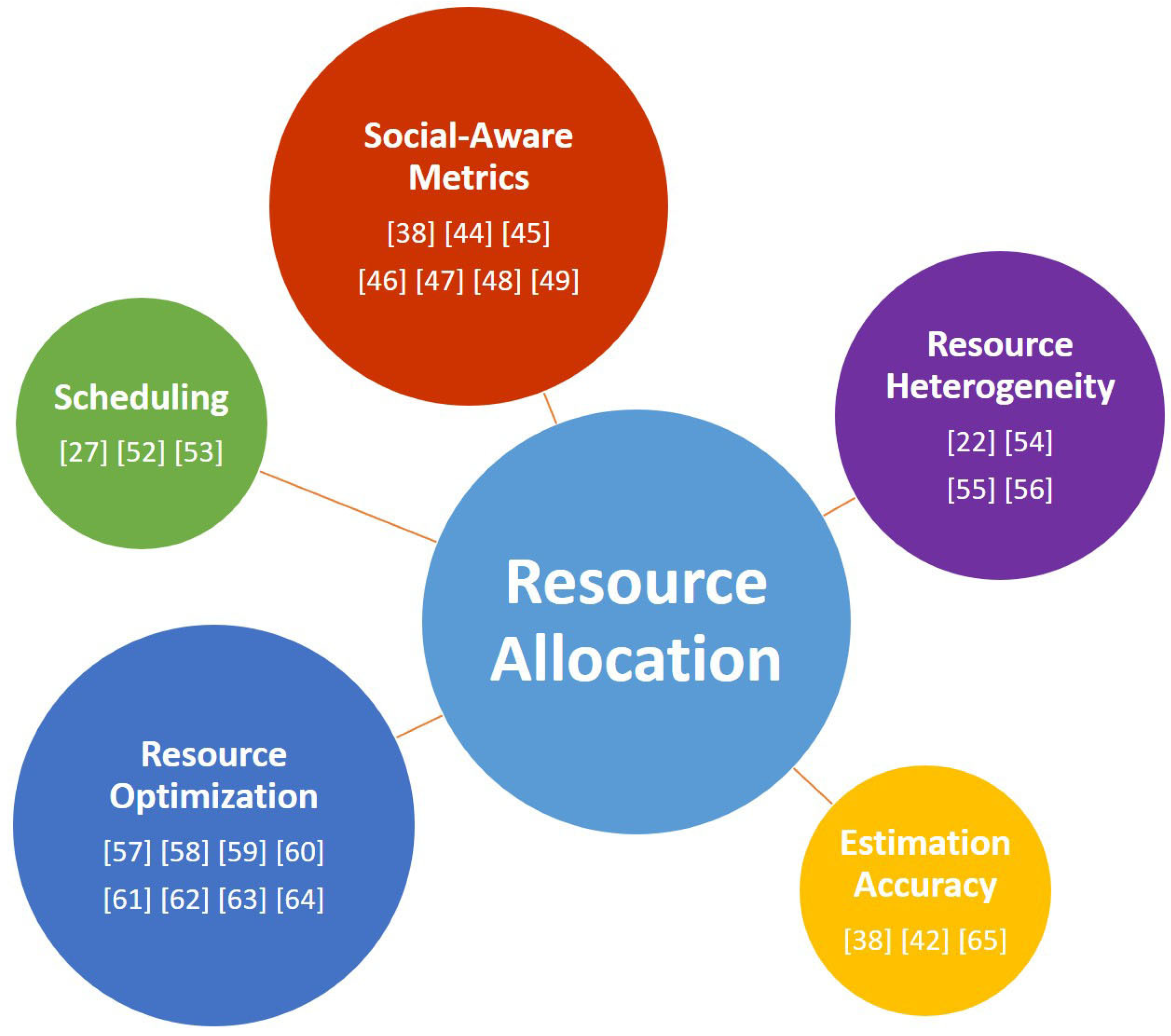When Social Networks Meet D2D Communications: A Survey
Abstract
1. Introduction
2. System Description
- the proximity of devices for assuring higher bitrates, lower delays and reduced power consumption;
- the reuse of resources by simultaneously allowing both D2D direct-link communications and “infrastructured” communications (e.g., cellular or WiFi); and
- the use of a single link rather than involving resources for both an up- and a downlink.
- Relay discovery and peer selection: The efficiency of a D2D communication is mainly related to the neighbor discovery process that is necessary prior to the effective direct communication. Peer selection can be time and energy consuming if network support is not available.
- Communication mode selection: A device can select either an established transmission channel respecting the procedures and constraints of the used network infrastructure, or a D2D communication. Involving all the devices to take this decision can improve data transmission capacity and resource utilization.
- Spectrum resource allocation and management: D2D communications use the same spectrum resource and air interfaces as normal, structured communications. To use these resources more efficiently, D2D communications may be performed for example by reusing the same frequency channels, involving decision and scheduling methods for spectrum sharing.
3. How Social Ties Can Improve D2D Communications
3.1. Relay Discovery and Peer Selection
3.2. Communication Mode Selection
3.3. Spectrum Resource Allocation and Management
- Social-aware metrics: Considering the high variability of social-aware D2D communications both in time and in the type of applications and relationships between users, allocation mechanisms need to assure dynamic generalization and adaptation.
- Scheduling: Dynamic scheduling algorithms are crucial to improve resource allocation evaluating the resources necessary to set the users’ application demands and assigning them.
- Resource Heterogeneity: It is in terms of device spectrum diversities (e.g., time variance of the spectrum and features of channels) and capabilities (e.g., throughput, energy, and interfaces helpful for transmission).
- Resource Optimization: These kinds of mechanisms can assure the usage of the available resources in a better way, meeting the required service level accordingly.
- Estimation Accuracy: Social interaction between devices needs to carefully manage the monitoring of social-aware D2D links.
- Privacy: It is crucial to be assured by enabling device protection and social information protection (e.g., encrypting data and deploying a rigid policies concerning access personal information).
4. Lesson Learned
5. Conclusions
Author Contributions
Funding
Conflicts of Interest
References
- Ahmed, E.; Yaqoob, I.; Gani, A.; Imran, M.; Guizani, M. Social-Aware Resource Allocation and Optimization for D2D Communication. IEEE Wirel. Commun. 2017, 24, 122–129. [Google Scholar] [CrossRef]
- Asadi, A.; Wang, Q.; Mancuso, V. A survey on device-to-device communication in cellular networks. IEEE Commun. Surv. Tutor. 2014, 16, 1801–1819. [Google Scholar] [CrossRef]
- Kleinberg, J. The convergence of social and technological networks. Commun. ACM 2008, 51, 66–72. [Google Scholar] [CrossRef]
- Atzori, L.; Iera, A.; Morabito, G.; Nitti, M. The social internet of things (siot)–when social networks meet the internet of things: Concept, architecture and network characterization. Comput. Netw. 2012, 56, 3594–3608. [Google Scholar] [CrossRef]
- Pilloni, V.; Navaratnam, P.; Vural, S.; Atzori, L.; Tafazolli, R. Cooperative task assignment for distributed deployment of applications in wsns. In Proceedings of the 2013 IEEE International Conference on Communications (ICC), Budapest, Hungary, 9–13 June 2013; pp. 2229–2234. [Google Scholar]
- Colistra, G.; Pilloni, V.; Atzori, L. Task allocation in group of nodes in the IoT: A consensus approach. In Proceedings of the 2014 IEEE International Conference on Communications (ICC), Sydney, NSW, Australia, 10–14 June 2014; pp. 23848–23853. [Google Scholar]
- Chen, X.; Proulx, B.; Gong, X.; Zhang, J. Social trust and social reciprocity based cooperative D2D communications. In Proceedings of the Fourteenth ACM International Symposium on Mobile Ad Hoc Networking and Computing, Bangalore, India, 29 July–1 August 2013; pp. 2187–2196. [Google Scholar]
- Zhang, G.; Yang, K.; Chen, H.H. Socially aware cluster formation and radio resource allocation in D2D networks. IEEE Wirel. Commun. 2016, 23, 68–73. [Google Scholar] [CrossRef]
- Xu, W.; Li, S.; Xu, Y.; Lin, X. Underlaid-D2D-assisted cooperative multicast based on social networks. Peer-to-Peer Netw. Appl. 2016, 9, 923–935. [Google Scholar] [CrossRef]
- Zhang, Z.; Wang, L.; Liu, D.; Zhang, Y. Peer discovery for D2D communications based on social attribute and service attribute. J. Netw. Comput. Appl. 2017, 86, 82–91. [Google Scholar] [CrossRef]
- Du, Q.; Song, H.; Zhu, X. Social-feature enabled communications among devices towards smart IoT community. arXiv, 2018; arXiv:1807.03590. [Google Scholar] [CrossRef]
- Zhang, Y.; Song, L.; Saad, W.; Dawy, Z.; Han, Z. Exploring social ties for enhanced device-to-device communications in wireless networks. In Proceedings of the 2013 IEEE Global Communications Conference (GLOBECOM), Atlanta, GA, USA, 9–13 December 2013; pp. 4597–4602. [Google Scholar]
- Wang, L.; Tang, H.; Čierny, M. Device-to-device link admission policy based on social interaction information. IEEE Trans. Veh. Technol. 2015, 64, 4180–4186. [Google Scholar] [CrossRef]
- Zhang, Y.; Pan, E.; Song, L.; Saad, W.; Dawy, Z.; Han, Z. Social network aware device-to-device communication in wireless networks. IEEE Trans. Wirel. Commun. 2015, 14, 177–190. [Google Scholar] [CrossRef]
- Zhang, B.; Li, Y.; Jin, D.; Hui, P.; Han, Z. Social-aware peer discovery for D2D communications underlaying cellular networks. IEEE Trans. Wirel. Commun. 2015, 14, 1528–1539. [Google Scholar] [CrossRef]
- Meng, Y.; Jiang, C.; Chen, H.H.; Ren, Y. Cooperative device-to-device communications: Social networking perspectives. IEEE Netw. 2017, 31, 38–44. [Google Scholar] [CrossRef]
- Ma, T.; Zhou, J.; Tang, M.; Tian, Y.; Al-Dhelaan, A.; Al-Rodhaan, M.; Lee, S. Social network and tag sources based augmenting collaborative recommender system. IEICE transactions on Information and Systems 2015, 98, 902–910. [Google Scholar] [CrossRef]
- Wang, R.; Yang, H.; Wang, H.; Wu, D. Social overlapping community-aware neighbor discovery for D2D communications. IEEE Wirel. Commun. 2016, 23, 28–34. [Google Scholar] [CrossRef]
- Chen, X.; Proulx, B.; Gong, X.; Zhang, J. Exploiting social ties for cooperative D2D communications: A mobile social networking case. IEEE/ACM Trans. Netw. (TON) 2015, 23, 1471–1484. [Google Scholar] [CrossRef]
- Zhang, H.; Wang, Z.; Du, Q. Social-Aware D2D Relay Networks for Stability Enhancement: An Optimal Stopping Approach. IEEE Trans. Veh. Technol. 2018, 67, 8860–8874. [Google Scholar] [CrossRef]
- Zhang, M.; Chen, X.; Zhang, J. Social-aware relay selection for cooperative networking: An optimal stopping approach. In Proceedings of the 2014 IEEE International Conference on Communications (ICC), Sydney, NSW, Australia, 10–14 June 2014; pp. 2257–2262. [Google Scholar]
- Chiti, F.; Fantacci, R.; Pierucci, L. Social-Aware Relay Selection for Cooperative Multicast Device-to-Device Communications. Future Internet 2017, 9, 92. [Google Scholar] [CrossRef]
- Militano, L.; Orsino, A.; Araniti, G.; Iera, A. NB-IoT for D2D-enhanced content uploading with social trustworthiness in 5G systems. Future Internet 2017, 9, 31. [Google Scholar] [CrossRef]
- Kumbhar, F.H.; Saxena, N.; Roy, A. Reliable Relay: Autonomous Social D2D Paradigm for 5G LoS Communications. IEEE Commun. Lett. 2017, 21, 1593–1596. [Google Scholar] [CrossRef]
- Militano, L.; Orsino, A.; Araniti, G.; Nitti, M.; Atzori, L.; Iera, A. Trusted D2D-based data uploading in in-band narrowband-IoT with social awareness. In Proceedings of the 2016 IEEE 27th Annual International Symposium on Personal, Indoor, and Mobile Radio Communications (PIMRC), Valencia, Spain, 4–8 September 2016; pp. 21–26. [Google Scholar]
- Militano, L.; Orsino, A.; Araniti, G.; Nitti, M.; Atzori, L.; Iera, A. Trust-based and social-aware coalition formation game for multihop data uploading in 5G systems. Comput. Netw. 2016, 111, 141–151. [Google Scholar] [CrossRef]
- Cao, Y.; Jiang, T.; Chen, X.; Zhang, J. Social-aware video multicast based on device-to-device communications. IEEE Trans. Mob. Comput. 2016, 15, 1528–1539. [Google Scholar] [CrossRef]
- Nitti, M.; Popescu, V.; Fadda, M. Using an IoT Platform for Trustworthy D2D Communications in a Real Indoor Environment. IEEE Trans. Netw. Serv. Manag. 2018. [Google Scholar] [CrossRef]
- Doppler, K.; Rinne, M.; Wijting, C.; Ribeiro, C.; Hugl, K. Device-to-device communication as an underlay to LTE-advanced networks. IEEE Commun. Mag. 2009, 47, 42–49. [Google Scholar] [CrossRef]
- Jiang, J.; Zhang, S.; Li, B. Maximized Cellular Traffic Offloading via Device-to-Device Content Sharing. IEEE J. Sel. Areas Commun. 2016, 34, 82–91. [Google Scholar] [CrossRef]
- Bai, B.; Wang, L.; Wang, Z.; Chen, W.; Svensson, T. Caching based socially-aware D2D communications in wireless content delivery networks: A hypergraph framework. IEEE Wirel. Commun. 2016, 23, 78–81. [Google Scholar] [CrossRef]
- Wu, D.; Zhou, L.; Cai, Y. Social-aware rate based content sharing mode selection for D2D content sharing scenarios. IEEE Trans. Multimed. 2017, 19, 2571–2582. [Google Scholar] [CrossRef]
- Hakola, S.; Chen, T.; Lehtomaki, J.; Koskela, T. Device-To-Device (D2D) Communication in Cellular Network-Performance Analysis of Optimum and Practical Communication Mode Selection. In Proceedings of the IEEE Wireless Communication and Networking Conference, Sydney, NSW, Australia, 18–21 April 2010; pp. 21–26. [Google Scholar]
- Doppler, K.; Yu, C.H.; Ribeiro, C.; Janis, P. Mode Selection for Device-To-Device Communication Underlaying an LTE-Advanced Network. In Proceedings of the IEEE Wireless Communication and Networking Conference, Sydney, NSW, Australia, 18–21 April 2010; pp. 21–26. [Google Scholar]
- Lei, L.; Zhong, Z.; Lin, C.; Shen, X. Operator controlled device-to-device communications in LTE-advanced networks. IEEE Wirel. Commun. 2016, 19, 96–104. [Google Scholar] [CrossRef]
- Li, Y.; Wang, Z.; Jin, D.; Chen, S. Optimal Mobile Content Downloading in Device-to-Device Communication Underlaying Cellular Networks. IEEE Trans. Wirel. Commun. 2014, 13, 3596–3608. [Google Scholar] [CrossRef]
- Min, H.; Seo, W.; Lee, J.; Park, S.; Hong, D. Reliability Improvement Using Receive Mode Selection in the Device-to-Device Uplink Period Underlaying Cellular Networks. IEEE Trans. Wirel. Commun. 2010, 10, 413–418. [Google Scholar] [CrossRef]
- Li, Y.; Wu, T.; Hui, P.; Jin, D.; Chen, S. Social-aware D2D communications: Qualitative insights and quantitative analysis. IEEE Commun. Mag. 2014, 52, 150–158. [Google Scholar] [CrossRef]
- Vastardis, N.; Yang, K. Mobile social networks: Architectures, social properties, and key research challenges. IEEE Commun. Surv. Tutor. 2013, 15, 1355–1371. [Google Scholar] [CrossRef]
- Hoeyhtyae, M.; Mammela, A.; Celentano, U.; Roening, J. Power-efficiency in social-aware D2D communications. In Proceedings of the European Wireless 2016; 22th European Wireless Conference, Oulu, Finland, 18–20 May 2016; pp. 21–26. [Google Scholar]
- Datsika, E.; Antonopoulos, A.; Zorba, N.; Verikoukis, C. Green cooperative device–to–device communication: A social–aware perspective. IEEE Access 2016, 4, 3697–3707. [Google Scholar] [CrossRef]
- Huynh, D.T.; Wang, X.; Duong, T.Q.; Vo, N.S.; Chen, M. Social-aware energy efficiency optimization for device-to-device communications in 5G networks. Comput. Commun. 2018, 120, 102–111. [Google Scholar] [CrossRef]
- Ansari, R.I.; Chrysostomou, C.; Hassan, S.A.; Guizani, M.; Mumtaz, S.; Rodriguez, J.; Rodrigues., J. 5G D2D Networks: Techniques, Challenges, and Future Prospects. IEEE Syst. J. 2017, 12, 3970–3984. [Google Scholar] [CrossRef]
- Nitti, M.; Murroni, M.; Fadda, M.; Atzori, L. Exploiting social internet of things features in cognitive radio. IEEE Access 2016, 4, 9204–9212. [Google Scholar] [CrossRef]
- Sun, Y.; Wang, T.; Song, L.; Han, Z. Efficient resource allocation for mobile social networks in D2D communication underlaying cellular networks. In Proceedings of the 2014 IEEE International Conference on Communications (ICC), Sydney, NSW, Australia, 10–14 June 2014; pp. 2466–2471. [Google Scholar]
- Zhao, Y.; Li, Y.L.; Cao, Y.; Jiang, T.; Ge, N. Social-Aware Resource Allocation for Device-to-Device Communications Underlaying Cellular Networks. IEEE Trans. Wirel. Commun. 2015, 14, 6621–6634. [Google Scholar] [CrossRef]
- Huang, Z.; Tian, H.; Fan, S.; Xing, Z.; Zhang, X. Social-aware resource allocation for content dissemination networks: An evolutionary game approach. IEEE Access 2017, 5, 9568–9579. [Google Scholar] [CrossRef]
- Li, Y.; Su, S.; Chen, S. Social-Aware Resource Allocation for Device-to-Device Communications Underlaying Cellular Networks. IEEE Wirel. Commun. Lett. 2015, 4, 293–296. [Google Scholar] [CrossRef]
- Zhang, G.; Yang, K.; Wu, S. Efficient Power Control for Half-Duplex Relay Based D2D Networks under Sum Power Constraints. Wirel. Netw. 2015, 21, 2345–2355. [Google Scholar] [CrossRef]
- Zhang, H.; Jiang, C.; Mao, X.; Chen, H.H. Interference-Limit Resource Optimization in Cognitive Femtocells with Fairness and Imperfect Spectrum Sensing. IEEE Trans. Veh. Tecnol. 2016, 65, 1761–1771. [Google Scholar] [CrossRef]
- Zhang, G.; Yang, K.; Liu, P.; Wei, J. Power Allocation for Full-Duplex Relaying-Based D2D Communication Underlaying Cellular Networks. IEEE Trans. Veh. Tecnol. 2015, 64, 4911–4916. [Google Scholar] [CrossRef]
- Yan, J.; Wu, D.; Zhang, C.; Wang, H.; Wang, R. Socially aware D2D cooperative communications for enhancing Internet of Things application. EURASIP J. Wirel. Commun. Netw. 2018, 2018, 132. [Google Scholar] [CrossRef]
- Jiang, L.; Tian, H.; Xing, Z.; Wang, K.; Zhang, K.; Maharjan, S.; Gjessing, S.; Zhang, Y. Social-aware energy harvesting device-to-device communications in 5G networks. IEEE Wirel. Commun. 2016, 23, 20–27. [Google Scholar] [CrossRef]
- Wang, F.; Li, Y.; Wang, Z.; Yang, Z. Social Community Aware Resource Allocation for D2D Communications Underlaying Cellular Networks. IEEE Trans. Veh. Technol. 2016, 65, 3628–3640. [Google Scholar] [CrossRef]
- Deng, G.; Shi, J.; Nie, G.; Huang, Z. Time-varying Social-aware Resource Allocation for Device-to-Device Communication. IEEE Access 2018. [Google Scholar] [CrossRef]
- Sakr, A.H.; Hossain, E. Cognitive and energy harvesting-based D2D communication in cellular networks: Stochastic geometry modeling and analysis. IEEE Trans. Commun. 2015, 63, 1867–1880. [Google Scholar] [CrossRef]
- Yu, C.H.; Doppler, K.; Ribeiro, C.B.; Tirkkonen, O. Resource sharing optimization for device-to-device communication underlaying cellular networks. IEEE Trans. Wirel. commun. 2011, 10, 2752–2763. [Google Scholar]
- Min, H.; Lee, J.; Park, S.; Hong, D. Capacity enhancement using an interference limited area for device-to-device uplink underlaying cellular networks. IEEE Trans. Wirel. Commun. 2011, 10, 3995–4000. [Google Scholar] [CrossRef]
- Fodor, G.; Dahlman, E.; Mildh, G.; Parkvall, S.; Reider, N.; Miklós, G.; Turányi, Z. Design aspects of network assisted device-to-device communications. IEEE Commun. Mag. 2012, 50. [Google Scholar] [CrossRef]
- Shah, V.; Fapojuwo, A. Socially Aware Resource Allocation for Device-to-Device Communication in Downlink OFDMA Networks. In Proceedings of the 2014 IEEE Wireless Communications and Networking Conference (WCNC), Istanbul, Turkey, 6–9 April 2014; pp. 21673–21678. [Google Scholar]
- Wang, L.; Liu, L.; Cao, X.; Tian, X.; Cheng, Y. Sociality-aware resource allocation for device-to-device communications in cellular networks. IET Commun. 2015, 9, 342–349. [Google Scholar] [CrossRef]
- Du, Q.; Liu, M.; Xu, Q.; Song, H.; Sun, L.; Ren, P. Interference-constrained routing over P2P-share enabled multi-hop D2D networks. Peer-to-Peer Netw. Appl. 2017, 10, 1354–1370. [Google Scholar] [CrossRef]
- Zlatanov, N.; Schober, R. Buffer-Aided Relaying With Adaptive Link Selection-Fixed and Mixed Rate Transmission. IEEE Trans. Inf. Theory 2013, 59, 2816–2840. [Google Scholar] [CrossRef]
- Jung, S.; Kim, J. A new way of extending network coverage: Relay-assisted D2D communications in 3GPP. ICT Express 2016, 2, 117–121. [Google Scholar] [CrossRef]
- Hasan, M.; Hossain, E. Distributed Resource Allocation for Relay-Aided Device-to-Device Communication Under Channel Uncertainties: A Stable Matching Approach. IEEE Trans. Commun. 2015, 63, 3882–3897. [Google Scholar] [CrossRef]
- Meszaros, J. The Conflict Between Privacy and Scientific Research in the GDPR. In Proceedings of the 2018 Pacific Neighborhood Consortium Annual Conference and Joint Meetings (PNC), San Francisco, CA, USA, 27–30 October 2018; pp. 1–6. [Google Scholar]




© 2019 by the authors. Licensee MDPI, Basel, Switzerland. This article is an open access article distributed under the terms and conditions of the Creative Commons Attribution (CC BY) license (http://creativecommons.org/licenses/by/4.0/).
Share and Cite
Nitti, M.; Stelea, G.A.; Popescu, V.; Fadda, M. When Social Networks Meet D2D Communications: A Survey. Sensors 2019, 19, 396. https://doi.org/10.3390/s19020396
Nitti M, Stelea GA, Popescu V, Fadda M. When Social Networks Meet D2D Communications: A Survey. Sensors. 2019; 19(2):396. https://doi.org/10.3390/s19020396
Chicago/Turabian StyleNitti, Michele, George Alex Stelea, Vlad Popescu, and Mauro Fadda. 2019. "When Social Networks Meet D2D Communications: A Survey" Sensors 19, no. 2: 396. https://doi.org/10.3390/s19020396
APA StyleNitti, M., Stelea, G. A., Popescu, V., & Fadda, M. (2019). When Social Networks Meet D2D Communications: A Survey. Sensors, 19(2), 396. https://doi.org/10.3390/s19020396






